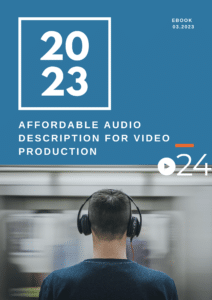Organizing your video libraries can play a significant role in creating an effective and searchable…

Striking the Right Balance: Blending Human and Synthetic Voices in Audio Description
The use of human and synthetic voices in audio description has been a hot debate and consideration lately. Both options have advantages and disadvantages, and they play a crucial role in shaping the overall quality of the audio description experience for individuals who are blind or visually impaired.
One of the benefits of using human voices in audio descriptions is the emotional connection they can create with the audience. Human narrators can convey the nuances of tone, emotion, and characterization in a way that resonates with the viewer, enhancing their understanding and enjoyment of the content. Human narrators can also add a personal touch to the description, making it feel more like a storytelling experience than a robotic narration. Using human voices can also provide opportunities for employment in the entertainment industry for narrators, creating jobs and promoting inclusivity in media production.

On the other hand, synthetic voices, also known as text-to-speech technology, offer some advantages. One of the main benefits of synthetic voices is consistency. Synthetic voices can be programmed to deliver consistent narration in tone, pacing, and pronunciation, ensuring that the audio description remains standardized throughout the content. Synthetic voices can also be more cost-effective than hiring human narrators, as they do not require ongoing payments or royalties. Additionally, synthetic voices can be generated in multiple languages, making audio descriptions accessible to a broader audience globally.
However, there are also challenges associated with synthetic voices. One of the main criticisms is the lack of emotional depth and human connection. Synthetic voices can sometimes sound robotic or monotonous, which may not be as engaging or enjoyable for the audience. Synthetic voices may also struggle to pronounce specific names, places, or specialized terms accurately, potentially leading to confusion or misinterpretation. Additionally, synthetic voices may raise ethical concerns, such as using artificial intelligence and potential biases in voice selection.
The Benefits of Human and Synthetic Voice Audio Description
Benefits of Human Voice Audio Description:
- Authenticity: Human voice audio description can provide a more authentic and emotional connection with the content, as the descriptions are natural and relatable.
- Emotional Impact: Human voice audio description can convey the emotional nuances of the scene, capturing the tone, mood, and expressions that synthetic voices may not easily replicate.
- Flexibility: Human voice audio description allows for flexibility in pacing and tone, enabling audio describers to adjust their delivery based on the content and context, and providing a more personalized experience for users.
- Familiarity: Human voice audio description can be more familiar to users who are accustomed to hearing human voices in other audio content, making it easier for them to relate to and engage with the descriptions.
Benefits of Synthetic Voice Audio Description
- Consistency: Synthetic voice audio description provides consistency in tone, pacing, and pronunciation, as the same voice can be used across multiple audio description tracks, ensuring a unified experience for users.
- Efficiency: Synthetic voice audio description can be generated automatically, saving time and effort in the production process and enabling faster turnaround times for audio description content.
- Accessibility: Synthetic voice audio description can be used to provide audio description in multiple languages and dialects, making it more accessible to a broader audience.
- Customization: Synthetic voice audio descriptions can be customized to suit the preferences of individual users, allowing for adjustments in voice speed, volume, and other parameters to enhance the listening experience.
- Lower Cost: Synthetic voice audio description can be more cost-effective than hiring human voice actors, which can benefit projects with budget constraints.
It’s important to note that the choice between human voice and synthetic voice audio description depends on various factors, including the costs, target audience, content type, and production constraints. The best approach may involve a combination of both human and synthetic voices, striking the right balance to ensure an inclusive and enjoyable audio description experience for all users.
Human and Synthetic Voices in Audio Description Summary
The choice between human and synthetic voices in audio description is complex. Both options have their benefits and limitations, and finding the right balance is crucial to ensure an engaging, accurate, and inclusive audio description experience for individuals who are blind or visually impaired. The field of audio description continues to evolve, and advancements in technology and narration techniques may further shape the future of audio description, ultimately enhancing the accessibility and inclusivity of visual content for all viewers. If you are seeking human or synthetic audio description, please contact cielo24 for more information about how we can advise and ensure you get the right solution for your needs.
cielo24 provides robust audio description solutions for visual media

 According to a survey by Verizon Media, 80% of consumers are more likely to watch an entire video when captions are available. Enjoy a complimentary trial account.
According to a survey by Verizon Media, 80% of consumers are more likely to watch an entire video when captions are available. Enjoy a complimentary trial account.
International organizations enjoy local hosting, a wide range of foreign languages, and other services; learn more.
Looking for Audio Description? Get started with WCAG 2.1 AA compliant Audio Description product. cielo24’s new Audio Description solution brings an improved video experience to people with low vision, vision impairment, and blindness. Give it a try now >>



